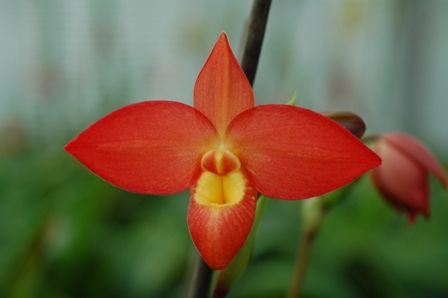Christopher Squire
A tropical paradise, the orchid enthusiast’s Mecca, a renowned hub of orchid study and archival artefacts, a lead centre for pioneering hybridization, call it what you will, but the Eric Young Orchid Foundation can certainly justify all of the above plaudits and is well worth a visit by seasoned orchidists and newcomers alike. Eric Young moved to Jersey from Derbyshire in the 1950’s and enjoyed considerable success as a local entrepreneur and philanthropist, amassing a considerable fortune before his death in 1992. An initial interest as an orchid hobbyist gradually evolved through stages of collector and nursery owner to a commitment to create a permanent tribute to the world of orchids and their cultivation. Eric spent liberally on his orchid collection and took pains to acquire some of the choicest clones available, thus bequeathing to the Foundation what we see today: some of the finest breeding stock in the world and a vibrant programme of continuous improvement through hybridization. Alas, with his death in 1992, Eric did not survive long enough to see the shape of his final project.
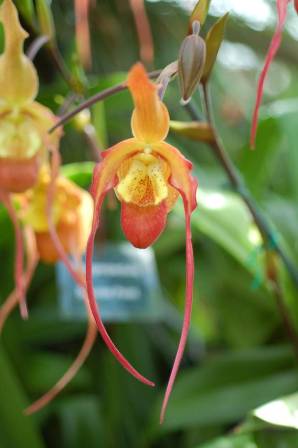
Phragmipedium ‘Quetivel Mill’
(Photo kindly supplied by D. Barthelemy)
It was a warm and sunny Thursday early last September when I finally achieved a long cherished objective to visit the Jersey Orchid Centre. Following a chance conversation in 2006, Colette and Dominique Barthelemy of la Canopée had suggested a joint visit and, after some initial misgivings, the logistics worked out perfectly. I took the fast ferry from Weymouth and the Barthelemys travelled over on the sister service from St. Malo. Rendezvous 09.00 hours St. Helier harbour! An appointment was pre-arranged with the Foundation curator, Chris Purver for 13.00 hours. Time for some very light refreshments in St. Helier (only very limited choice at the Foundation itself) and a slow bus ride out to Victoria Village. Jersey has a well appointed, cheap and friendly bus network and though you can hire a car, bus travel is recommended. Even if the timing of the ideal route is not exactly right, there is sure to be another adjacent service which does the trick with just an extra 500m of legwork. As the bus trundles slowly through the St. Helier suburbs, names and destination plates loom right and left, evoking a cast list from many an orchid catalogue, such as Fort Regent, Gorey Castle, Bouley Bay, Longueville, Tour de Rozel, les Augrès, Trinité, etc each conjuring up in the mind’s eye a notable BOC prize-winner.
Phragmipedium Don Wimber
Upon arrival, we took some time to visit the exhibition conservatory at our leisure, feasting on the sumptuous displays of species and hybrids for a memorable photographic record. The main exhibition area underwent significant enlargement in 2002 and now soars skyward like a veritable cathedral with boughs of cork encased scaffolding festooned with species of Oncidium, Dendrobium, Coelogyne, Encyclia and Laelia. Unlike many other notable glasshouse collections, you really do feel here that the plants have staked their claim, and are truly colonizing their particular micro-climates. Beds and alcoves below are richly planted with hybrids of almost every genus – odontoglossums, phragmipediums, cattleyas, lycastes, pleurothallids, cymbidiums and of course phalaenopsis. These displays are regularly changed according to season, ensuring that there is always something to see. (And here in September, we were supposed to be visiting during the low season for flowers) A minimum temperature of 16-17 Degrees C is maintained by conventional oil fired system using large diameter concealed pipes and floors are sprayed each morning to achieve required humidity levels. Ventilation fans are roof-based and primarily used to push the heat back downwards in winter. As Chris Purver later so correctly commented, here lie the advantages of being able to house your orchids in a large growing area. Plenty of natural air movement and climatic conditions which change relatively slowly. The roof shading is computer-controlled with varying combinations of Aluminium strips. The major problem for the Jersey centre is being able to control excessive heat and light during some unpredictable summers, especially for the odontoglossums, pleurothallids and phragmipediums.
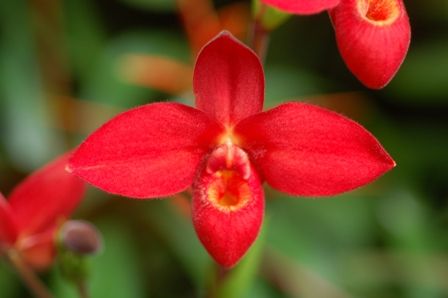
Phragmipedium Jason Fischer
As your gaze wanders from the exhibition conservatory across the walkway to the eight adjoining growing houses, it becomes increasingly difficult to believe that the entire establishment is managed by just 8-10 people, of which only 4-5 are regularly working with the plants themselves. The sap rises, the appetite whetted and you are instinctively enticed towards the growing houses, a veritable Aladdin’s cave. This area is not routinely open to the general public, so prior appointment is essential should you wish to look behind the scenes. The eight houses comprise 2 warm houses (phalaenopsis, cattleyas, calanthes plus warmer growing paphiopedilums), 2 specific Cymbidium Houses, 1 cool house (for odontoglossums, lycastes etc) and 3 further houses spanning the various subtleties of the Intermediate family, amongst these a magnificent showing of phragmipediums. In the cool house, there is a superb range of odontoglossum hybrids, one of the early specialities of Eric Young but waning in popularity in recent years in favour of the warm-tolerant intergenerics. Banks of ventilation fans and an under bench fogging system are a pre-requisite for maintaining cool humid conditions and avoidance of some local water quality issues. Tastes change and the orchid world is no exception. The Foundation must to an extent inevitably mirror the mood of the market with a transition from species to hybrids in the 60s to 80s and reverting back to species and intergenerics in more recent times. The Foundation is equipped with its own compact laboratory and here all the new crosses, the life-blood of the future, are raised in banks of flasks under sodium lamps. The emphasis here is on propagation from seed with minimal meristem activity except for the occasional rescue of a virus infected stock plant. A good tip from Chris Purver for those embarking on raising plants from flasks is to always de-flask in the spring when there is optimum natural light to encourage rapid growth.

Calanthe masuca
Certainly one of the most important areas of current research for the Foundation is in the area of paphiopedilums and more recently phragmipediums. The growing area is particularly striking with a wide range of these diverse genera, spanning cool to warm growing conditions. The recent hybridization programme is, even now, showing truly impressive results in terms of flower shape, number and colour. On view already were some outstanding specimens of Phragmipedium Jason Fischer, P.Don Wimber x P.andreetiae, P.kovachii x P.Dick Clements and P.kovachii x P.lindleyanum var. sargentianum. Chris Purver and team have some particularly high hopes for the quality of more recent P.kovachii crosses and the first flowering plants are showing immense promise. Watch this space !! Paphiopedilums are not my particular forte but, en passant, I could not help admiring a huge specimen plant of Phragmipedium fletcherianum. Then there was that London-awarded specimen of Eulophiella roempleriana and a very rare plant of Ida dyeriana, standing out as veteran campaigners, standard bearers amongst the legions of quality plants on view.
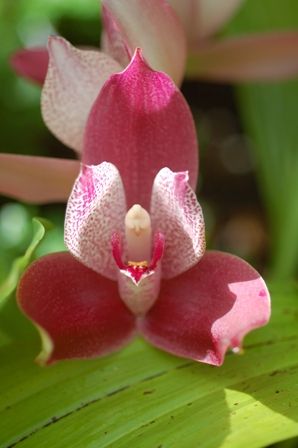
Lycaste Hybrid
As we stroll around, somewhat awestruck by the feast of fantasy before our eyes there is photo-snapping at every opportunity and the periodic break to exchange some interesting cultural tips with Chris. Following the disappearance of good quality bark, rockwool has become the potting medium of preference at the Foundation. There are some exceptions of course. The Cattleya alliance has been returned to bark, calanthes and phalaenopsis are potted in coarse peat, though this is not an ideal solution as the peat degrades fairly rapidly and often necessitates twice-yearly re-potting. Rockwool provides a good balance between water retention and drainability and enables plenty of air to percolate between the roots. One cardinal rule is that the rockwool mix should never be compacted. Given the right cultural conditions, the plants grow away strongly and a vigorous root system prevents them from falling out of the pot. It is usually helpful to provide a good layer of crock at the bottom of each pot and, for the larger specimens, some further surface counter-weighting may be appropriate. Plants in the rockwool mix may be watered up to three times per week, depending on the season and prevailing weather conditions. A foliar feed of magnesium nitrate is applied once per week together with a small amount of household washing-up detergent to assist the wetting process. One useful tip for those people contemplating changing the potting material or indeed re-potting in general, is to withhold water completely after initially watering the re-potted plant for a period of two to six weeks. This should encourage plants to generate new roots more rapidly as they search for moisture. An occasional misting of the foliage and surface of the compost will prevent dehydration.

Phragmipedium St Ouen
Not only did Eric Young put together an extensive collection of plants, he also amassed significant quantities of orchid memorabilia, and the archives at Victoria Village today boast one of the finest and most important collections of orchid books, catalogues and botanical art. This includes a full collection of Curtis’s Botanical Magazine, the Bateman illustrated library and all the Sander’s lists. Protective gloves donned, Chris Purver leafed carefully through volumes of exquisitely detailed orchid illustrations dating back to the eighteenth century. At an average value of £5000 per illustration for some of the oldest material you can appreciate the overall importance and value of this collection. We felt suitably in awe on seeing this veritable treasure trove which sealed a truly memorable visit to the Jersey Orchid Foundation. A scheduled two hour visit turned into a four hour spectacular.
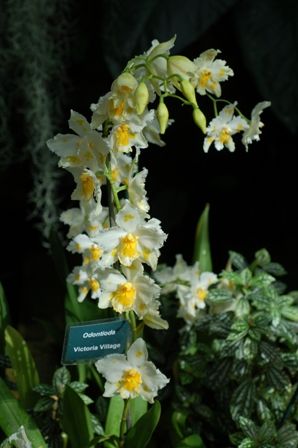
Odontioda Victoria Village
